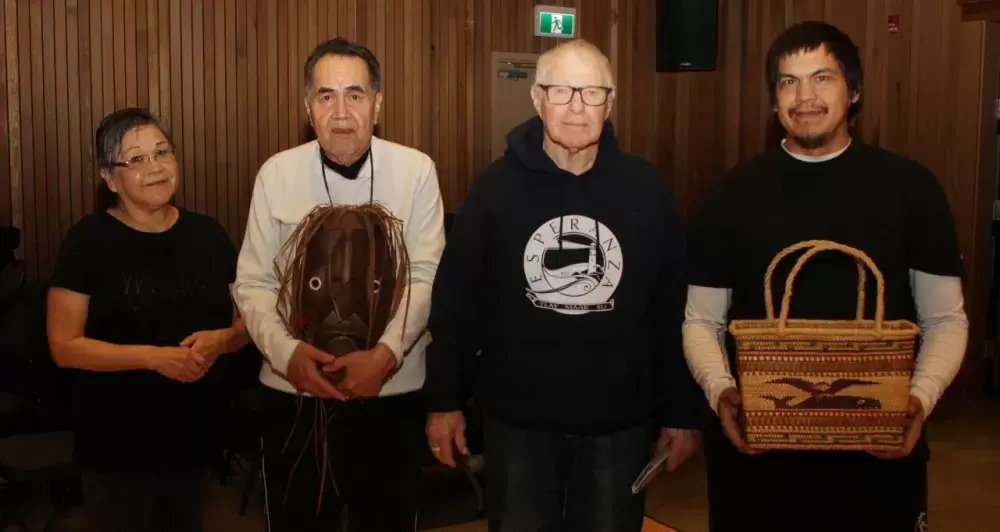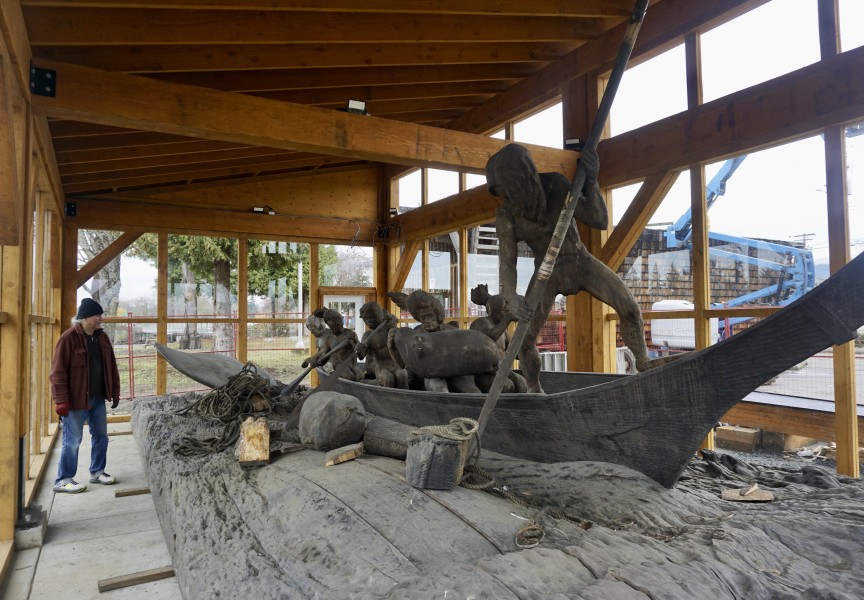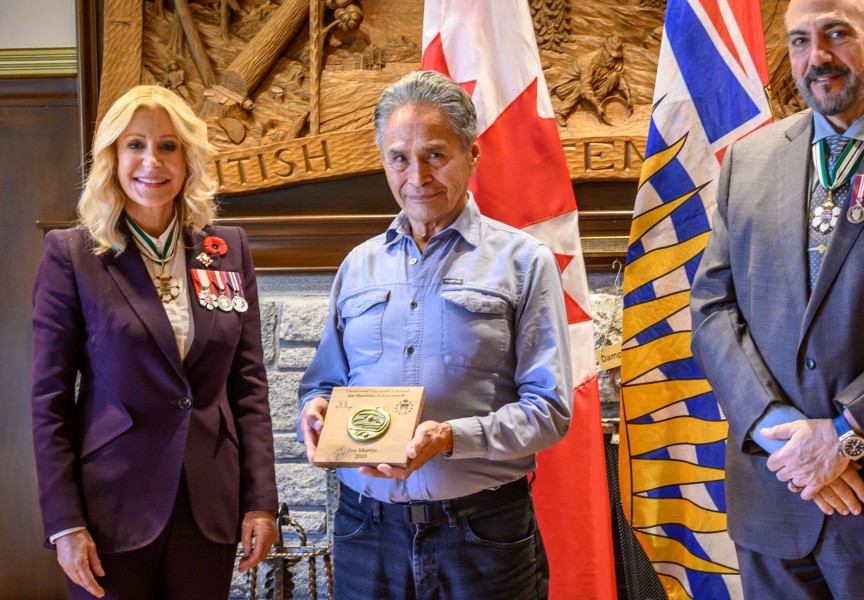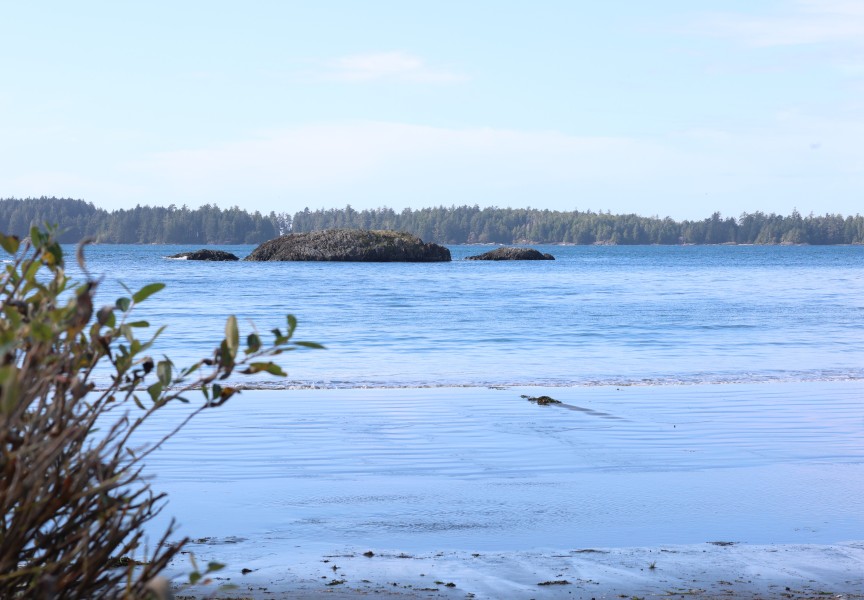His voice shaking with emotion, Frank Collins unpacked a large blue tote before a crowd on a winter evening at the Mowachaht/Muchalaht First Nation’s House of Unity. The 81-year-old removed a wooden mask and woven basket, two fixtures in his home for generations, handing them to the descendants of the artisans who created and sold the pieces several decades ago.
For Collins as well as the family members of late Mowachaht/Muchalaht carver Ambrose Howard and weaver Lillian Michael from the Nuchatlaht First Nation, the Feb. 23 event represented a homecoming for the pieces when they returned to the families that created them. This became a necessary gesture for the Tahsis resident since his wife Lucille, who collected First Nations art for most of her life, passed nearly four years ago.
“I’ve already donated three pieces to the Tahsis museum,” said Collins of works that include a small Ambrose Howard mask, a print by Sanford Williams and another basket by Lillian Michael. “We had it in our will if we passed together that all of our native art was going to go to the Campbell River museum.”
As the president of the Tahsis Salmon Enhancement Society, Collins is in regular contact with the Mowchaht/Muchalaht First Nation. His desire to send the pieces somewhere other than a museum intensified after hearing from the First Nation’s fisheries manager Kadin Snook that a permanent space for such artwork could be developing in the future.
“Kadin mentioned something about a culture centre here,” said Collins. “We decided that it should come here.”
Part of Lucille’s collection was a large number of woven cedar baskets, including the recently repatriated Lillian Michael piece that was purchased in the 1970s when the couple lived in Gold River. The mask was bought in the late 1960s, but Collins believes it was made during the previous decade when Ambrose Howard still lived in Yuquot, on the southern tip of Nootka Island.
As a child William Howard recalls his productive father honing the craft in his workshop while they lived in the ancient Mowachaht village.
“Every time I went in there he was sitting in there carving,” said Howard, whose father passed the craft on to him when Ambrose wasn’t selling pieces to interested buyers from around the world.
Even before the family moved to Gold River in the 1960s when the Mowachaht/Muchalaht reserve was translocated by the federal government, Howard would see visitors coming to their home in the remote Yuquot community to buy his father’s masks.
“They would come in and I’d never know where they were from,” he said.
Howard chuckles that his father once made a mask for him, an undertaking that took four to five months due to the constant demand for Ambrose’s product. A few times the father even took the work in progress off the wall to satisfy another eager customer, only to start his son’s mask over again.
“He wasn’t finished theirs so he would take mine, and he’d start making another one. He did that about three times,” admitted Howard. “He told me one time that when he first started carving it was - in my words - therapy, until he started selling it.”
Originally from Newfoundland, Collins has been a resident in Vancouver Island’s west coast communities since 1963. While Ambrose Howard and Lillian Michael were spreading their pieces through the world, Collins worked in industries that helped establish Gold River and Tahsis, often working alongside families represented at the event in the House of Unity.
“I worked at the old beach camp before the town was even built,” he said of his role in Gold River’s origins.
His ties to the families of these small communities on the northwest of Vancouver Island led to returning the mask and basket, amid plans among the Mowachaht/Muchalaht First Nation to eventually have the artwork on display.
“I was offered $5,000 for that mask,” said Collins of a pitch from a private American collector. “I didn’t want it hanging on a wall in Seattle. It had to come here - $5,000 wouldn’t have made me rich, but giving that there tonight made me very rich.”
“I think that was the biggest part of it; bringing it home, because I love these people,” he continued. “They’ve always been good to me, and they’ve always respected me.”







